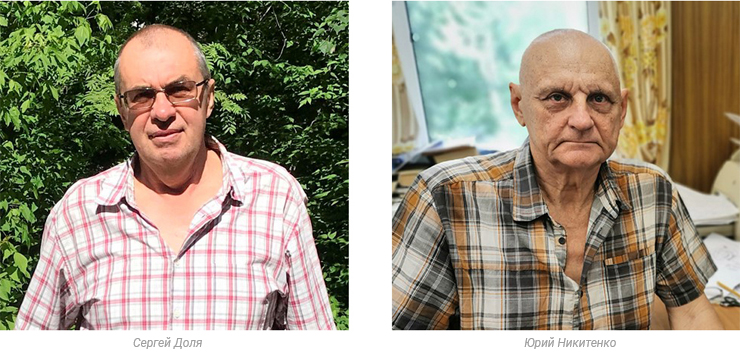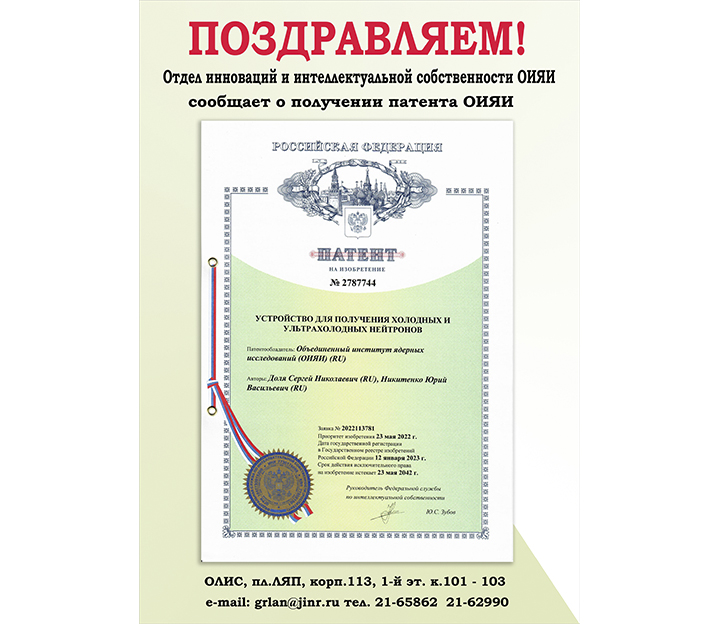New device for decelerating neutrons invented at JINR
News, 09 February 2023
A device for producing cold and ultracold neutrons has been designed at the Joint Institute for Nuclear Research. Ultracold neutrons (UCN) are widely used in the elementary particle physics and fundamental interactions thanks to their property to be reflected from a surface of certain materials at any angle of incidence, unlike neutrons of other energies that scatter in the surrounding matter very fast. In the scientific world, scientists have not completely solved the problem of neutron deceleration, because there are great losses of particles at the output in many well-known devices. The new JINR device contributes to solving this problem.
The idea of the invention is to decelerate a beam of thermal neutrons coming out of the reactor moderator either to cold neutrons at the velocity of about 10-100 m/s or to ultracold ones at the velocity less than 6 m/s using a system of moving diffraction neutron mirrors. Afterwards, specialists set up a trap on the beam trajectory, the entrance to which is blocked by a special shutter. A DLNP JINR researcher Sergey Dolya and an FLNP JINR leading researcher Yuri Nikitenko are the authors of the invention.
A neutron mirror is a polished multilayer material made of nickel and titanium or a nickel-titanium composite on a substrate. Such a material reflects neutron beams in the same way as an ordinary mirror reflects visible light. Just as light waves are reflected from the surface of the usual mirror, neutrons, also having a certain wavelength, are reflected from the neutron mirror. Neutron waves in the mirror interfere with each other, making layers, so that the intensity of the reflected wave increases dramatically.
 Fig.1 shows the spatial profile of the neutron interaction potential with the periodic mirror structure, in which layers alternately have positive +U1 (nickel) and negative -U2 (titanium) potentials. Potential jump values directly affect the neutron reflection coefficient from such a multilayer structure
Fig.1 shows the spatial profile of the neutron interaction potential with the periodic mirror structure, in which layers alternately have positive +U1 (nickel) and negative -U2 (titanium) potentials. Potential jump values directly affect the neutron reflection coefficient from such a multilayer structure
“If a neutron catches up with a mirror moving away from it, it will decelerate while being reflected from such a mirror, because double mirror velocity is deducted from neutron velocity during the reflection. If neutron velocity in a laboratory system is twice as fast as mirror velocity, the neutron will stop moving after being reflected,” Sergey Dolya, a co-author of the invention, explained. He said that earlier, since the late 60s of the twentieth century, scientists have already used spherical mirrors to reduce the energy of neutrons. However, modern diffraction mirrors have much higher efficiency and allow reflecting neutrons in a wider energy range. It is possible to change the spatial period of modern mirrors, the distance at which the order of layers sputtered on the mirror repeats. At the same time, the energy of the reflected neutrons also changes at the output.
In the new invention, the authors used diffraction mirrors rotating with high velocity, about 150 m/s, hung up on hinges. “They transfer neutrons from the region of thermal neutrons to the region of cold or ultracold ones. The double mirror velocity is deducted from their initial one. If the mirror is hung up on a hinge so that it can focus neutrons reflecting from it on the entrance of the trap or the neutron storage ring, it will allow scientists to obtain a large number of neutrons,” Sergey Dolya concluded.
According to the authors’ proposal, some diffraction mirrors with a flat reflecting surface should be made in a form of a layered structure, which is a system of layers followed one by one with the decreasing spatial period along the depth of the structure from its surface. Hemispherical neutron reflectors attached with the help of hinges to brackets located at the outer spokes of the wheel with a radius of about 1 m change their angle of inclination synchronously with the rotation of the wheel. The technical result is an increase in the neutron flux and an increase in the range of initial neutron velocity.
 Fig. 2. The device implementing the claimed method of producing cold and ultracold neutrons with parabolic diffraction mirrors attached to the bracket using hinges. At any moment, each of several mirrors focuses reflected neutrons on the entrance slit of the trap designed to store UCN. (1) – the mirror rotation system, (2) – the entrance slit of the trap for UCN
Fig. 2. The device implementing the claimed method of producing cold and ultracold neutrons with parabolic diffraction mirrors attached to the bracket using hinges. At any moment, each of several mirrors focuses reflected neutrons on the entrance slit of the trap designed to store UCN. (1) – the mirror rotation system, (2) – the entrance slit of the trap for UCN
“Ultracold neutrons have been attracting the attention of physicists for a long time,” Sergey Dolya noted. The long storage time of neutrons in a trap allows scientists to use UCN, for example, in experiments to determine their fundamental properties, as well as in materials science.
“However, cold neutrons can also be stored. In addition, their flux is higher than the flux of ultracold neutrons. Therefore, it is more beneficial to use cold neutrons in some experiments,” Yuri Nikitenko noted. One of the effective way to implement a storage ring for such neutrons is a proposal by Yuri Nikitenko, a patent of which the Joint Institute received a patent in 2022. The same author previously developed a new method for measuring losses in a cold neutron storage ring.
The new invention by Sergey Dolya and Yuri Nikitenko could be applied at NEPTUN, the future reactor of JINR.

